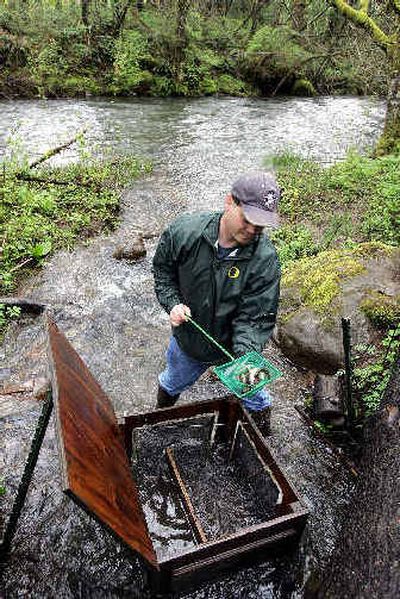Feds approve salmon plan

VANCOUVER, Wash. – The first in a series of locally produced blueprints for salmon recovery in the Columbia Basin was endorsed Monday by federal authorities, who will roll it into a comprehensive plan for the region by next year.
The draft plan for restoring habitat and populations of threatened chum and chinook salmon and steelhead in watersheds draining into the lower Columbia River from Washington comes more than a decade after the first of a dozen species of salmon came under Endangered Species Act protection in the Columbia Basin.
“It’s a radically different approach for endangered species recovery,” said Bob Lohn, northwest regional director of NOAA Fisheries, the federal agency in charge of protecting threatened and endangered salmon.
The draft plan evaluates the distribution, diversity, abundance and productivity of salmon populations, and the current risk of extinction. It includes a comprehensive analysis of factors holding salmon populations down, such as fishing, hatchery management, hydroelectric operations, habitat and estuary conditions, and predators, and what should be done to overcome them.
The draft plan also sets specific goals that will be used in the future to assess whether protected fish can be taken off the endangered species list.
It is the first locally produced blueprint for salmon recovery ever endorsed by NOAA Fisheries in the Northwest. The proposal fits into a Bush administration concept of generating recovery plans required under the Endangered Species Act from the grassroots up, rather than handing them down from federal agencies, Lohn added.
Others will follow from Oregon, Idaho and the rest of Washington by the end of the year, when NOAA Fisheries will roll them into its own comprehensive plan, including dam operations on the Columbia and Snake rivers, said NOAA Fisheries spokesman Brian Gorman. Plans are to be final by next year.
“This really does mark a turning point in the story of salmon management in the Northwest,” said Rob Masonis, Northwest regional director for American Rivers, a conservation group. “For a long time, we’ve been focused on preventing stocks from going extinct. Now we are talking about trying to recover abundant populations that are fishable.”
Save Our Salmon, another conservation group, said in a release that since 2001, most runs of wild salmon in the Columbia Basin have been in decline.
This year, overall salmon returns counted at Bonneville Dam on the Columbia River have been dramatically down, with no clear reason why.
The draft plan was produced by the Lower Columbia Fish Recovery Board over the past 3 1/2 years at a cost of $1.2 million, said Jeff Breckel, executive director of the group. The group was created by the Washington Legislature in 1998 as a pilot project and includes representatives of local governments, the Cowlitz Tribe, private property openers, environmentalists and others.
The decline of salmon runs up and down the West Coast came under a spotlight in 1991, when the American Fisheries Society put out a report declaring 214 runs in danger of extinction. In the years that followed, a total of 25 runs on the West Coast, including the 12 in the Columbia Basin, were listed as threatened or endangered by NOAA Fisheries.
Scientists figure between 30 percent and 50 percent of salmon habitat has been lost to logging, agriculture, dams and urban development over the past 150 years, said Elizabeth Gaar, chief of NOAA Fisheries’ salmon recovery branch.
Lohn estimated that the overall job of restoring dwindling salmon runs, from habitat projects in streams to major hydroelectric dam operations, is about a third completed.